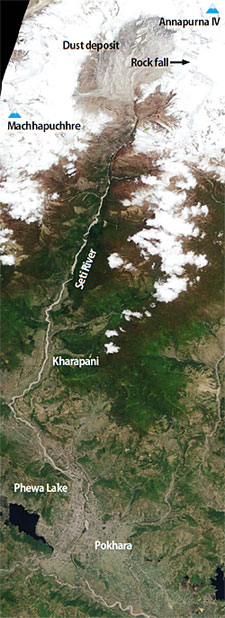 AVIA CLUB NEPAL THE DAY AFTER: Captain Alexander Maximov of Avia Club Nepal took this photograph on 6 May showing clearly where the rock face broke off near the 7,525m summit of Annapurna IV (near where the wingtip camera is in the picture) and fell on the ice shelf below, creating a cloud of dust and triggering an avalanche that burst into the Seti gorge. |
 The NASA image was taken on 20 May . |
The aftermath of that event is still visible as monsoon rains lash the Seti Basin, washing down more of the sediment deposited upstream. What is flowing down the Seti this week is not water, but a muddy white paste.
That Saturday morning, Russian pilot Alexander Maximov of Avia Club Nepal in Pokhara was flying a tourist on a sightseeing flight at 10,000ft above the Seti and filming it all from a video camera on the wingtip of his blue Aeroprakt plane. Inadvertently, he recorded the dust cloud created by the rock-ice avalanche, and noticed the flash flood coming down the Seti. He radioed a warning to Pokhara that possibly saved many lives, and then raced the flood down the Seti Valley, taking aerial pictures of the river as it tore through villages.
Maximov flew back the next day and took amazing photographs of the devastation on the ice shelf below the 7,525m-high Annapurna IV in the headwaters of the Seti. Scientists analysing those images have concluded that a rock face very near the summit of Annapurna IV broke off, taking down a part of the ice cornice of the ridge as well.
David Petley a professor at Durham University writes in The Landslide Blog: 'It is clear that the landslide is a huge rockslope failure �on the flanks of Annapurna IV. The mass appears to have fragmented when it reached the lower angled slopes at the foot of the steep section, and to have runout as a rock and debris avalanche.'
Also taking pictures in the days after the event were the eyes in the sky of NASA's Landsat satellite. The image taken on 6 May shows an enormous brown area below the cliff where the rock slide pulverised, and sent a cloud of dust that was carried northwards to the base of the ridgeline between Annapurna III and IV, which separates Kaski from Manang. Despite a technical glitch, the Landsat image also shows the channels through which the avalanche plunged to the Seti below and caused the devastating flashflood downstream.
Interestingly, the rockfall was not caused by an earthquake, but it created an earthquake that was detected by the Lamont-Doherty Earth Observatory of Columbia University in the US. Experts there concluded that the landslide moved from east to west and dislodged some 22 million cubic metres of rock that first fell 2,000m into the ice shelf below Annapurna IV and then another 2,000m into the Seti. There, the avalanche of rock and ice moved at 30 metres per second and pushed the water down the River at high speed.
The Seti has seen much bigger floods in its history, one of them occuring about 800 years ago which was of biblical proportions and brought down a wall of debris 100m high to what is now Pokhara city.
Climate change and future earthquakes will exacerbate this danger. Risk management experts say it is better to be prepared with a flood early warning system, and zoning laws that discourage settlements and infrastructure along river banks.
Kunda Dixit
Read also:
Seti's orphans, CANDICE NEO in POKHARA
Two months after the Seti flashflood, victims struggle to overcome the disaster and rebuild their lives
See also:
Alexander Maximov's video of the dust cloud from the avalanche
David Petley's The Landslide Blog
Himalayan Tsunami, Kunda Dixit's East-West Blog


